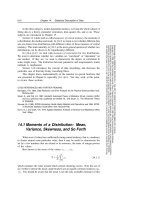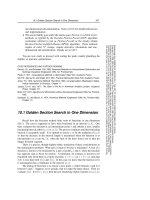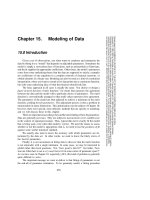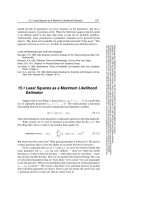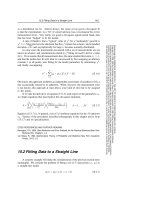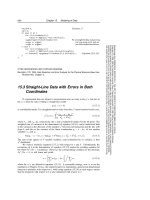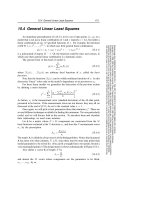Tài liệu Modeling of Data part 2 doc
Bạn đang xem bản rút gọn của tài liệu. Xem và tải ngay bản đầy đủ của tài liệu tại đây (90.33 KB, 5 trang )
15.1 Least Squares as a Maximum Likelihood Estimator
657
Sample page from NUMERICAL RECIPES IN C: THE ART OF SCIENTIFIC COMPUTING (ISBN 0-521-43108-5)
Copyright (C) 1988-1992 by Cambridge University Press.Programs Copyright (C) 1988-1992 by Numerical Recipes Software.
Permission is granted for internet users to make one paper copy for their own personal use. Further reproduction, or any copying of machine-
readable files (including this one) to any servercomputer, is strictly prohibited. To order Numerical Recipes books,diskettes, or CDROMs
visit website or call 1-800-872-7423 (North America only),or send email to (outside North America).
should provide (i) parameters, (ii) error estimates on the parameters, and (iii) a
statistical measure of goodness-of-fit. When the third item suggests that the model
is an unlikely match to the data, then items (i) and (ii) are probably worthless.
Unfortunately, many practitioners of parameter estimation never proceed beyond
item (i). They deem a fit acceptable if a graph of data and model “looks good.” This
approach is known as chi-by-eye. Luckily, its practitioners get what they deserve.
CITED REFERENCES AND FURTHER READING:
Bevington, P.R. 1969,
Data Reduction and Error Analysis for the Physical Sciences
(New York:
McGraw-Hill).
Brownlee, K.A. 1965,
Statistical Theory and Methodology
, 2nd ed. (New York: Wiley).
Martin, B.R. 1971,
Statistics for Physicists
(New York: Academic Press).
von Mises, R. 1964,
Mathematical Theory of Probability and Statistics
(New York: Academic
Press), Chapter X.
Korn, G.A., and Korn, T.M. 1968,
Mathematical Handbook for Scientists and Engineers
, 2nd ed.
(New York: McGraw-Hill), Chapters 18–19.
15.1 Least Squares as a Maximum Likelihood
Estimator
Suppose that we are fitting N data points (x
i
,y
i
)i=1,...,N, to a model that
has M adjustable parameters a
j
,j=1,...,M. The model predicts a functional
relationship between the measured independent and dependent variables,
y(x)=y(x;a
1
...a
M
)(15.1.1)
where thedependence on theparameters is indicated explicitlyon the right-handside.
What, exactly, do we want to minimize to get fitted values for the a
j
’s? The
first thing that comes to mind is the familiar least-squares fit,
minimize over a
1
...a
M
:
N
i=1
[y
i
− y(x
i
; a
1
...a
M
)]
2
(15.1.2)
But where does this come from? What general principles is it based on? The answer
to these questions takes us into the subject of maximum likelihood estimators.
Given a particular data set of x
i
’s and y
i
’s, we have the intuitive feeling that
some parameter sets a
1
...a
M
are very unlikely — those for which the model
function y(x) looks nothing like the data — while othersmay be very likely— those
that closely resemble the data. How can we quantify this intuitive feeling? How can
we select fitted parameters that are “most likely” to be correct? It is not meaningful
to ask the question, “What is the probability that a particular set of fitted parameters
a
1
...a
M
is correct?” The reason is that there is no statistical universe of models
from which the parameters are drawn. There is just one model, the correct one, and
a statistical universe of data sets that are drawn from it!
658
Chapter 15. Modeling of Data
Sample page from NUMERICAL RECIPES IN C: THE ART OF SCIENTIFIC COMPUTING (ISBN 0-521-43108-5)
Copyright (C) 1988-1992 by Cambridge University Press.Programs Copyright (C) 1988-1992 by Numerical Recipes Software.
Permission is granted for internet users to make one paper copy for their own personal use. Further reproduction, or any copying of machine-
readable files (including this one) to any servercomputer, is strictly prohibited. To order Numerical Recipes books,diskettes, or CDROMs
visit website or call 1-800-872-7423 (North America only),or send email to (outside North America).
That being the case, we can, however, turn the question around, and ask, “Given
a particular set of parameters, what is the probability that this data set could have
occurred?” If the y
i
’s take on continuous values, the probability will always be
zero unless we add the phrase, “...plus or minus some fixed ∆y on each data point.”
So let’s always take this phrase as understood. If the probability of obtaining the
data set is infinitesimally small, then we can conclude that the parameters under
consideration are “unlikely” to be right. Conversely, our intuition tells us that the
data set should not be too improbable for the correct choice of parameters.
In other words, we identify the probability of the data given the parameters
(which is a mathematically computable number), as the likelihood of the parameters
given the data. This identification is entirely based on intuition. It has no formal
mathematical basis in and of itself; as we already remarked, statistics is not a
branch of mathematics!
Once we make this intuitive identification, however, it is only a small further
step to decide to fit for the parameters a
1
...a
M
precisely by finding those values
that maximize the likelihood defined in the above way. This form of parameter
estimation is maximum likelihood estimation.
We are now ready to make the connection to (15.1.2). Suppose that each data
point y
i
has a measurement error that is independently random and distributed as a
normal (Gaussian) distribution around the “true” model y(x). And suppose that the
standard deviations σ of these normal distributionsare the same for all points. Then
the probability of the data set is the product of the probabilities of each point,
P ∝
N
i=1
exp
−
1
2
y
i
− y(x
i
)
σ
2
∆y
(15.1.3)
Notice that there is a factor ∆y in each term in the product. Maximizing (15.1.3) is
equivalent to maximizing its logarithm, or minimizing the negative of its logarithm,
namely,
N
i=1
[y
i
− y(x
i
)]
2
2σ
2
− N log ∆y (15.1.4)
Since N, σ,and∆yare all constants, minimizing this equation is equivalent to
minimizing (15.1.2).
What we see is that least-squares fitting is a maximum likelihood estimation
of the fitted parameters if the measurement errors are independent and normally
distributed with constant standard deviation. Notice that we made no assumption
about the linearity or nonlinearity of the model y(x; a
1
...) in its parameters
a
1
...a
M
. Just below, we will relax our assumption of constant standard deviations
and obtain the very similar formulas for what is called “chi-square fitting” or
“weighted least-squares fitting.” First, however, let us discuss further our very
stringent assumption of a normal distribution.
For a hundred years or so, mathematical statisticians have been in love with
the fact that the probability distribution of the sum of a very large number of very
small random deviations almost always converges to a normal distribution. (For
precise statements of this central limit theorem, consult
[1]
or other standard works
on mathematical statistics.) This infatuation tended to focus interest away from the
15.1 Least Squares as a Maximum Likelihood Estimator
659
Sample page from NUMERICAL RECIPES IN C: THE ART OF SCIENTIFIC COMPUTING (ISBN 0-521-43108-5)
Copyright (C) 1988-1992 by Cambridge University Press.Programs Copyright (C) 1988-1992 by Numerical Recipes Software.
Permission is granted for internet users to make one paper copy for their own personal use. Further reproduction, or any copying of machine-
readable files (including this one) to any servercomputer, is strictly prohibited. To order Numerical Recipes books,diskettes, or CDROMs
visit website or call 1-800-872-7423 (North America only),or send email to (outside North America).
fact that, for real data, the normal distribution is often rather poorly realized, if it is
realized at all. We are often taught, rather casually, that, on average, measurements
will fall within ±σ of the true value 68 percent of the time, within ±2σ 95 percent
of the time, and within ±3σ 99.7 percent of the time. Extending this, one would
expect a measurement to be off by ±20σ only one time out of 2 × 10
88
.Weall
know that “glitches” are much more likely than that!
In some instances, the deviations from a normal distribution are easy to
understand and quantify. For example, in measurements obtained by counting
events, the measurement errors are usually distributed as a Poisson distribution,
whose cumulative probability function was already discussed in §6.2. When the
number ofcountsgoing intoone datapoint islarge, the Poissondistributionconverges
towards a Gaussian. However, the convergence is not uniform when measured in
fractional accuracy. The more standard deviations out on the tail of the distribution,
the larger the number of counts must be before a value close to the Gaussian is
realized. The sign of the effect is always the same: The Gaussian predicts that “tail”
events are much less likely than they actually (by Poisson) are. This causes such
events, when they occur, to skew a least-squares fit much more than they ought.
Other times, the deviations from a normal distribution are not so easy to
understand in detail. Experimental points are occasionally just way off. Perhaps
the power flickered during a point’s measurement, or someone kicked the apparatus,
or someone wrote down a wrong number. Points like this are called outliers.
They can easily turn a least-squares fit on otherwise adequate data into nonsense.
Their probability of occurrence in the assumed Gaussian model is so small that the
maximum likelihood estimator is willing to distort the whole curve to try to bring
them, mistakenly, into line.
The subject of robust statistics deals with cases where the normal or Gaussian
model is a bad approximation, or cases where outliers are important. We will discuss
robust methods briefly in §15.7. All the sections between this one and that one
assume, one way or the other, a Gaussian model for the measurement errors in the
data. It it quite important that you keep the limitations of that model in mind, even
as you use the very useful methods that follow from assuming it.
Finally, note that our discussion of measurement errors has been limited to
statistical errors, the kind that will average away if we only take enough data.
Measurements are also susceptible to systematic errors that will not go away with
any amount of averaging. For example, the calibration of a metal meter stick might
depend on its temperature. If we take all our measurements at the same wrong
temperature, then no amount of averaging or numerical processing will correct for
this unrecognized systematic error.
Chi-Square Fitting
We considered the chi-square statistic once before, in §14.3. Here it arises
in a slightly different context.
If each data point (x
i
,y
i
)has its own, known standard deviation σ
i
,then
equation (15.1.3) is modified only by putting a subscript i on the symbol σ.That
subscript also propagates docilely into (15.1.4), so that the maximum likelihood
660
Chapter 15. Modeling of Data
Sample page from NUMERICAL RECIPES IN C: THE ART OF SCIENTIFIC COMPUTING (ISBN 0-521-43108-5)
Copyright (C) 1988-1992 by Cambridge University Press.Programs Copyright (C) 1988-1992 by Numerical Recipes Software.
Permission is granted for internet users to make one paper copy for their own personal use. Further reproduction, or any copying of machine-
readable files (including this one) to any servercomputer, is strictly prohibited. To order Numerical Recipes books,diskettes, or CDROMs
visit website or call 1-800-872-7423 (North America only),or send email to (outside North America).
estimate of the model parameters is obtained by minimizing the quantity
χ
2
≡
N
i=1
y
i
− y(x
i
; a
1
...a
M
)
σ
i
2
(15.1.5)
called the “chi-square.”
To whatever extent themeasurement errors actuallyare normallydistributed,the
quantityχ
2
is correspondinglya sum of N squares of normally distributedquantities,
each normalized to unit variance. Once we have adjusted the a
1
...a
M
to minimize
the value of χ
2
, the terms in the sum are not all statistically independent. For models
that are linear in the a’s, however, it turns out that the probability distribution for
different values of χ
2
at its minimum can nevertheless be derived analytically, and
is the chi-square distribution for N − M degrees of freedom. We learned how to
compute this probability function using the incomplete gamma function gammq in
§6.2. In particular, equation (6.2.18) gives the probability Q that the chi-square
should exceed a particular value χ
2
by chance, where ν = N − M is the number of
degrees of freedom. The quantity Q, or its complement P ≡ 1 − Q, is frequently
tabulated in appendices to statistics books, but we generally find it easier to use
gammq and compute our own values: Q = gammq (0.5ν, 0.5χ
2
). It is quite common,
and usually not too wrong, to assume that the chi-square distribution holds even for
models that are not strictly linear in the a’s.
This computed probability gives a quantitative measure for the goodness-of-fit
of the model. If Q is a very small probability for some particular data set, then the
apparent discrepancies are unlikely to be chance fluctuations. Much more probably
either(i) themodel is wrong — can be statisticallyrejected, or (ii)someone has liedto
you about the size of the measurement errors σ
i
— they are really larger than stated.
It is an important point that the chi-square probability Q does not directly
measure the credibility of the assumption that the measurement errors are normally
distributed. It assumes they are. In most, but not all, cases, however, the effect of
nonnormal errors is to create an abundance of outlier points. These decrease the
probabilityQ, so that we can add another possible, though less definitive, conclusion
to the above list: (iii) the measurement errors may not be normally distributed.
Possibility (iii) is fairly common, and also fairly benign. It is for this reason
that reasonable experimenters are often rather tolerant of low probabilities Q.Itis
not uncommon to deem acceptable on equal terms any models with, say, Q>0.001.
This is not as sloppy as it sounds: Truly wrong models will often be rejected with
vastly smaller values of Q, 10
−18
, say. However, if day-in and day-out you find
yourself accepting models with Q ∼ 10
−3
, you really should track down the cause.
If you happen to know the actual distribution law of your measurement errors,
then you might wish to Monte Carlo simulate some data sets drawn from a particular
model, cf. §7.2–§7.3. You can then subject these synthetic data sets to your actual
fitting procedure, so as to determine both the probability distribution of the χ
2
statistic, and also the accuracy with which your model parameters are reproduced
by the fit. We discuss this further in §15.6. The technique is very general, but it
can also be very expensive.
At theoppositeextreme, it sometimeshappens that the probabilityQ istoo large,
too near to 1, literally too good to be true! Nonnormal measurement errors cannot
in general produce this disease, since the normal distribution is about as “compact”
15.2 Fitting Data to a Straight Line
661
Sample page from NUMERICAL RECIPES IN C: THE ART OF SCIENTIFIC COMPUTING (ISBN 0-521-43108-5)
Copyright (C) 1988-1992 by Cambridge University Press.Programs Copyright (C) 1988-1992 by Numerical Recipes Software.
Permission is granted for internet users to make one paper copy for their own personal use. Further reproduction, or any copying of machine-
readable files (including this one) to any servercomputer, is strictly prohibited. To order Numerical Recipes books,diskettes, or CDROMs
visit website or call 1-800-872-7423 (North America only),or send email to (outside North America).
as a distribution can be. Almost always, the cause of too good a chi-square fit
is that the experimenter, in a “fit” of conservativism, has overestimated his or her
measurement errors. Very rarely, too good a chi-square signals actual fraud, data
that has been “fudged” to fit the model.
A rule of thumb is that a “typical” value of χ
2
for a “moderately” good fit is
χ
2
≈ ν. More precise is the statement thatthe χ
2
statistichas a mean ν and a standard
deviation
√
2ν, and, asymptotically for large ν, becomes normally distributed.
In some cases the uncertainties associated with a set of measurements are not
known in advance, and considerations related to χ
2
fitting are used to derive a value
for σ. If we assume that all measurements have the same standard deviation, σ
i
= σ,
and that the model does fit well, then we can proceed by first assigning an arbitrary
constant σ to all points, next fitting for the model parameters by minimizing χ
2
,
and finally recomputing
σ
2
=
N
i=1
[y
i
− y(x
i
)]
2
/(N − M)(15.1.6)
Obviously, this approach prohibits an independent assessment of goodness-of-fit, a
fact occasionally missed by its adherents. When, however, the measurement error
is not known, this approach at least allows some kind of error bar to be assigned
to the points.
If we take the derivative of equation (15.1.5) with respect to the parameters a
k
,
we obtain equations that must hold at the chi-square minimum,
0=
N
i=1
y
i
− y(x
i
)
σ
2
i
∂y(x
i
; ...a
k
...)
∂a
k
k =1,...,M (15.1.7)
Equation (15.1.7) is, in general, a set of M nonlinear equations for the M unknown
a
k
. Various of the procedures described subsequently in this chapter derive from
(15.1.7) and its specializations.
CITED REFERENCES AND FURTHER READING:
Bevington, P.R. 1969,
Data Reduction and Error Analysis for the Physical Sciences
(New York:
McGraw-Hill), Chapters 1–4.
von Mises, R. 1964,
Mathematical Theory of Probability and Statistics
(New York: Academic
Press),
§
VI.C. [1]
15.2 Fitting Data to a Straight Line
A concrete example will make the considerations of the previous section more
meaningful. We consider the problem of fitting a set of N data points (x
i
,y
i
)to
a straight-line model
y(x)=y(x;a, b)=a+bx (15.2.1)
